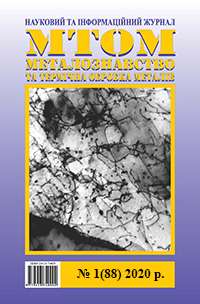SERVICE DURABILITY IMPROVEMENT OF HOT SAWS BY HEAT TREATMENT
DOI:
https://doi.org/10.30838/J.PMHTM.2413.260222.70.635Keywords:
hot saw, heat treatment, service durability, “scoring” defect, “cut” defect, hardness, quenchingAbstract
Purpose of the study. To determine the improvement potential of service durability of hot saws by heat treatment of saw teeth. To develop the optimal heat treatment modes in order to obtain the higher service durability of hot saws. To implement the optimal heat treatment mode into industrial practice of hot saw treatment. Methodology. Investigation of the structure of hot saws has been carried out using light microscopes Neophot 32 and Axiovert 200M MAT with AxioVision 4.6.3 software. The hardness of hot saw teeth has been assessed by Vickers method. Microhardness has been determined by PMT-3 test equipment. Results. It has been established that the use of blowing of saw tooth in all tested modes leads to a decrease in the total depth of the heat affected zone, primarily due to a decrease in the depth of the transition zone. It is shown that an amperage decrease in all the tested modes reduces the depth of the heat affected zone. It has been experimentally proved that an increase in the contact area between the heater and the tooth significantly (1,5…2 times) increases the depth of the heat affected zone. This is mainly due to an increase in the depth of the transition zone. In this case, the hardness of the quenched zone is slightly reduced. It is proved that most of the regularities previously defined for the structure of cold saw disks are also true for the structure of hot saw disks, despite significantly different operating conditions. Practical significance. It was possible to increase the depth of the hardened layer of hot saw teeth up to 80 % of the height of the cutting element. However, based on the manufacturability of the resizing of the disks during operation, the depth of the hardened zone was limited to 40…50 % of the height of the tooth. The quality of the hot cut has been improved; the number of defects of the "cuts" and "scoring" type has been decreased significantly. The durability of hot saw disks increased by at least 5 %.
References
Nasad T.G. Vysokoskorostnaya obrabotka s teplovym vozdeystviyem [High speed heat treatment : monograph]. Saratovskyi State Technical University, 2007. 108 p. (in Russian).
Bannikov A.I. Sovershenstvovaniye protsessa rezaniya goryachego metalloprokata diskovymi pilami na osnove upravleniya teplofizicheskimi yavleniyami v kontaktnoy zone: dissertatsiya doktora Tekhnicheskikh nauk: 05.02.07 [Improving the process of cutting hot metal by circular saws based on the management of thermophysical phenomena in the contact zone: diss. Dr. Sc. (Tech.) : 05.02.07]. Volhohrad : FGBOU VO “Volhohradskyi State Technival University”, 2018, 306 p. (in Russian).
Talanov N.V. Fizicheskiye osnovy protsessa rezaniya [The physical basis of the cutting process]. Fizicheskiye protsessy pri rezanii metallov [Physical processes in metal cutting]. 1984, pp. 3–37. (in Russian).
Bannikov A.I. Teoreticheskiye osnovy modernizatsii pil udarnogo reza goryachego prokata: monografiya [Theoretical Foundations for the Modernization of Hot-Impact Saw Cutting Saws : monograph]. Volhohrad : VolhSTU, 2014, 108 p. (in Russian).
Vorontsov A.L., Albagachiyev A. Yu. and Sultan–zade N.M. Teoreticheskiye osnovy obrabotki metallov v mashinostroyenii [Theoretical foundations of metal processing in mechanical engineering]. Staryy Oskol : TNT, 2014, 552 p. (in Russian).
Gismetulin A.R., Gorbunov I.V. and Yefremenkov I.V. Razrabotka preprotsessora dlya modelirovaniya operatsiy mekhanoobrabotki v SAYe sisteme LS–DYNA [Development of a preprocessor for modeling machining operations in the SAELS–DYNA system]. Izvestiya Samarskogo nauchnogo tsentra Rossiyskoy akademii nauk [Bulletin of the Samara Scientific Center of the Russian Academy of Sciences]. 2014, vol. 16, no. 1 (5), pp. 1338–1342.
Yekobori T. Fizika i mekhanika razrusheniya i prochnost' tverdykh tel [Physics and mechanics of fracture and solid strength]. Moscow : Metallurgiya, 1971, pp. 141–149. (in Russian).
V.I. Bolʹshakov, V.M. Volchuk and Yu.I. Dubrov. Shlyakhy vidstezhuvannya transformatsiy mikrostruktury materialu, yaki vidbuvayutʹsya vnaslidok yoho znos [Ways to track the transformation of the microstructure of a material due to its wear]. Shostyy mizhnarodnyy sympozium ukrayinsʹkykh inzheneriv-mekhanikiv u Lʹvovi: tezy dopovidey [Sixth International Symposium of Ukrainian Mechanical Engineers in Lviv: Abstracts]. Edited by Cand. Sc. (Tech.), Dr. B.I. Kindratsʹkyi. Lʹviv : KINPATRI LTD, 2003, pp. 145−146. (in Ukrainian).
Andreyev G.S. Teplovyye yavleniya v rezhushchey chasti instrumenta pri preryvistom rezanii [Thermal phenomena in the cutting part of the tool during intermittent cutting]. Vestnik mashinostroyeniya [Bulletin of mechanical engineering]. 1973, no. 3, pp. 69–73.
Plakhotnik V.A. and Konskaya A.A. Opredeleniye temperaturnogo polya v poverkhnostnom sloye zagotovki pri termofriktsionnom rezanii [Determination of the temperature field in the surface layer of a workpiece during thermofriction cutting]. Vestnik SNU imeni Dalya [Bulletin of SNU named after Dahl]. 2013, no. 4 (2), pp. 150–152.
Dal'skiy A.M. Spravochnik tekhnologa–mashinostroitelya [Handbook of a mechanical engineer]. In 2 vol. Edited by A.M. Dal'skyi, A.G. Kosilova, R.K. Meshcheryakov, A.G. Suslov. Moscow : Mashinostroyeniye, 2010, vol. 1, 912 p. (in Russian).
Kalinovskiy V.R. Tekhnologiya goryachey obrabotki metallov [Hot metal processing technology]. Minsk : IVTs Minfina, 2008, 352 p. (in Russian).
Bannikov A.I., Dyatlov N.A., Permyakov I.L., Antonov A.S. Metallograficheskoye issledovaniye struzhki pri udarnoy rezke goryachego prokata [Metallographic study of shavings during impact cutting of hot rolled products]. STIN [Steel & Instruments]. 2014, no. 4, pp. 19–20. (in Russian).
Uzlov O.V., Drozhevsʹka H.V., Puchykov O.V. and Hrechka I.S. Pidvyshchennya resursu ekspluatatsiyi dyskiv pyl kholodnoho rizannya metalu shlyakhom termichnoyi obrobky [Increasing the service life of cold-cut metal saw blades by heat treatment]. Metaloznavstvo ta termichna obrobka metaliv [Metal Science and Heat Treatment of Metals]. No. 4 (87), 2019, pp. 10−16. (in Ukrainian).
Downloads
Published
Issue
Section
License
Authors that are published in this journal agree to follow the conditions:
Authors reserve the right to the authorship of his work and cede the right to the journal of first publication of this work on conditions of the license under the Creative Commons Attribution License, which allows others to distribute it freely with the obligatory reference to the author of the original work and the first publication of the work in this journal.

